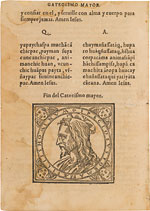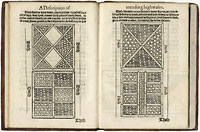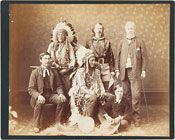Alphabet Soup
P is for Painted Bindings
Fore-Edge Fancies, Swann & Bloomsbury Auctions, New York, $450 & $1,920
The market for painted fore-edge bindings is stronger in the U.S. than in Britain, though in many cases the books were printed and decorated in England. Among a small group in a 12 March Swann sale was this 1904 edition of Longfellow’s verse, sporting a fore-edge painting of two doctors examining a young man’s (or is it a schoolboy’s?) abdomen. It sold at $450. The polished red calf binding bears the gilt insignia of Queen Elizabeth’s School, Hartlebury.
There were more painted fore-edge bindings in a Bloomsbury Auctions sale of 4 April. Two 1864 volumes of prayer, painted with portraits of Washington and Lincoln, sold at $1,920. In the latter volume, Lincoln’s portrait is flanked by views of his modest birthplace and the White House.
Q is for Quichua
South American Sermons, Swann, New York, $72,000
In most circumstances, any book that is stained throughout and lacks the title-page, preliminaries, and a good many other early leaves is going to have a hard time at auction. Doctrina Christiana, y Catecismo para Instruccion de los Indios, however, being the first book published on the South American continent, breaks from the usual rules on condition.
The Concilio Provincial of Lima had ordered the compilation of sermons and catechisms for use by missionaries in their attempts to convert the indigenous Peruvian peoples to Catholicism; Antonio Ricardi, who had come from Mexico to Peru to set up a press, took the commercial opportunity this order offered, and the book was printed in Lima in 1584.
Disbound and trimmed slightly unevenly, as well as stained and incomplete, the copy seen at Swann on 2 April was valued at $10,000–15,000, but the only other copy that appears in auction records is another defective example sold as long ago as 1965, and this battered survivor of a work of huge importance in the study of Andean languages was bid up to $72,000. The letters Q and A above the two larger blocks of text indicate the Quichua and Aymará versions of the Spanish text.
Two days later in New York, at Bloomsbury Auctions, a manuscript vocabulary of the Cakchiquel language of Guatemala, in large part a Spanish-Cakchiquel dictionary of over 11,000 words drawn up in 1695 by Father Domingo de Bassaeta at Zacualpa in the province of Solala, was sold at $28,800.
R is for Roadworks
17th-Century Highway Improvements, Bonhams, London, $3,090
I am sure that the manuals and instruction books look very different today, but seen here are two of the 10 woodcuts, showing different methods of laying roads, found in Thomas Procter’s early-17th-century A Profitable Worke to this Whole Kingdome. Concerning the mending of the High-Wayes.
Procter’s treatise was intended to show methods by which improvements could be made to communications in Britain, “whereby all the said high-waies shall or may-bee made more sound and strong, pleasant and comfortable for all maner of way-faring journeying, or traveling with cartes and carriages.”
A copy seen at Bonhams on March 24 was a 1610 second issue of this scarce work. In rebacked contemporary calf, it had a couple of faults—one leaf shaved close enough at the fore-margin to touch the illustration, and a lost line on the cropped final leaf replaced in facsimile—but it sold at the high estimate of £2,160 ($3,090) to UK dealer Roger Gaskell.
W is for Wild West
Buffalo Bill Memorabilia, Swann, New York, $9,600
In 1992 Roger Hollander retired to a ranch near Cody, Wyoming, that had once been Buffalo Bill Cody’s hunting lodge. In a collection of western photographs, books, and manuscripts he assembled there, Buffalo Bill memorabilia was inevitably prominent and featured strongly among items from his collection sold by Swanns on March 26.
Bid to $9,600 by an unnamed institution was an 1885 account ledger for the early days of Cody’s travelling Wild West Show. The names of Cody, his long-time manager Nate Salsbury, and two of the show’s star turns, Bronco Bill and Annie Oakley, appear in a ledger that also records payments to Sitting Bull and his interpreter, William Halsey, along with detailed expenses relating to ammunition, livery, animals, Indian goods, and much more.
Among photographs in the Hollander collection was this group portrait, ca. 1885, which made $4,560. Standing at the back are Crow Eagle, Buffalo Bill himself, and William ‘Adirondack’ Murray, clergyman, champion of the outdoor life, and author of Adventures in the Wilderness; or, Camp-Life in the Adirondacks. In front of them is Sitting Bull, flanked by Halsey and Johnny “Cowboy Kid” Baker, seated cross-legged on the floor. Johnny was nine years old when he met Buffalo Bill, who seems to have regarded himself as a foster parent. Johnny was with the show from the start and developed marksmanship skills that were unorthodox but rivalled those of Annie Oakley.








 Ian McKay’s weekly column in Antiques Trade Gazette has been running for more than 30 years.
Ian McKay’s weekly column in Antiques Trade Gazette has been running for more than 30 years.


